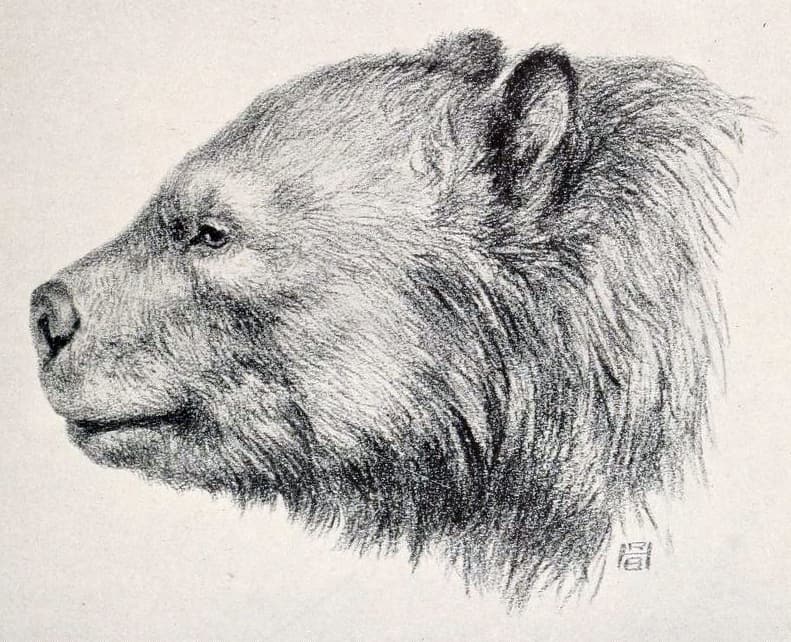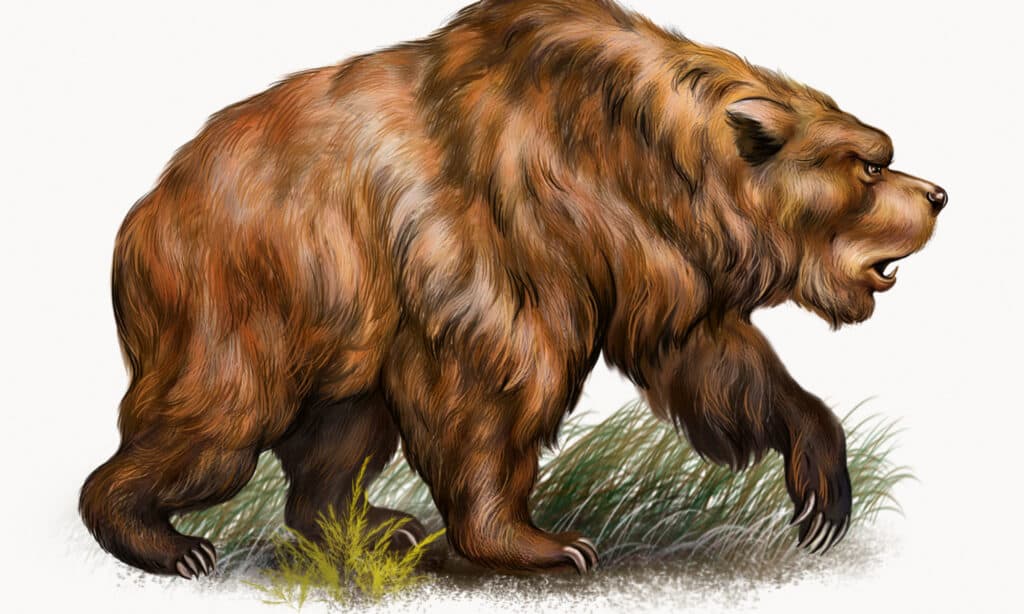Modern bears are some of the largest animals in the world. However, prehistoric bears are much larger and more ferocious than modern bears. This phenomenon could be because ancient bears had to fight with ferocious animals for survival. These animals include cave lions and dire wolves. These bears lived as far back as the Pleistocene era, between 11,000 and 2.5 million years ago.
Scientists believe these bears evolved into giants to sight vultures. When they see vultures gathering on a fresh kill, they see an opportunity for an easy meal. They do this to avoid having to go hunting themselves. These bears had a mix of an herbivorous and carnivorous diet. This article will discuss a few of these ancient bears and how huge they were.
List of giant ancient bears
The bears we shall discuss lived millions of years ago. This era was a period when most animals were also giants. These animals include the carnivores and megaherbivores of the time. These bears had to evolve in size to stand a chance at survival. These giant ancient bears include:
Arctodus simus (Giant short-faced bear)

.
©Daniel Eskridge/Shutterstock.com
The enormous short-faced bear shares genetic similarities with the Arctotherium genus. This bear is one of the rare animals that has ventured to compete in size with the Arctotherium. Short-faced bears initially arrived in what is now the United States about 800,000 years ago. Shortly after, they spread into and throughout Canada. This bear weighed 2,000 pounds and measured about six feet tall at the shoulder. These enormous bears can grow to 12 feet tall at their prime age.
The short-faced bear’s size worked against it. This phenomenon is similar to the fate of the Arctotherium. Scientists initially assumed this bear preyed on whatever animal it encountered. Later discovery revealed that this bear lacked turning skills. The lack of this skill made it a terrible ambush predator. New hypotheses propose that the bear would slog along after its prey. This method helps wear it down with better stamina. According to other experts, the bear likely pressured other predators into giving up their prey.
These bears possess sharp, shearing teeth. This revelation and the shape of the skull reveal that it is a carnivore. It had an excellent vision due to how wide its eye sockets were. It possessed a sizeable nasal tube in its wide snout. This feature indicates that it had a high sense of smell. It also shows that it could inhale large amounts of oxygen when chasing prey. The jaws were vast and short. This bear also had massive teeth for ferocious bites. This feature gave the bear a lethal bite and also the ability to easily crush bones for marrow.
The high nitrogen level the bones reveal also indicates a carnivore. These bears lived around Minnesota, west of the Mississippi River, Yukon, and Alaska. This bear mainly preyed on animals like bison, muskox, deer, caribou, horses, and ground sloths. Like most other enormous animals of the time, the extinction of these bears was due to habitat changes. This change came as the Ice Age ended.
Agriotherium africanum
This bear is often called the bear with the crushing bite. Tyrannus was a more enormous and brown bear-like polar bear than the current one. Their bones were comparable to brown bears’, although considerably bigger. They were about 6 feet tall at the shoulder and over 12 feet long. These bears weighed over 2,500 pounds on average. These features make them the world’s largest carnivorous terrestrial animal.
Scientists believe the bear developed this characteristic to cope with the stress of battling prey with its teeth. Over time these bears developed the ability to crush bone and muscle. This ability helped these bears go for the vitals when hunting prey. When it wasn’t hunting for itself, this strong bear ate carrion. This bear also used its unique jaw to cut off large meat sections to preserve for later.
Scientists believe this bear enjoyed vegetation as well. This notion is supported by the fact that the giant panda has the most powerful biting force. The ancient bear may have chewed through tough plants with its massive teeth. It existed during the Miocene epoch and was discovered all over the planet.
At first sight, this bear does not appear to be particularly unique. It’s roughly the size of a modern grizzly bear, and it also appears like one. However, checking this bear’s skull and teeth will reveal great bite force. The africanum bear has the most ferocious bite of any living or extinct bear. This bite force gave it the ability to crush practically anything.
Ursus maritimus tyrannus (King polar bear)
Little is known about this ancient polar bear species. The little that we know comes from a single partial ulna found near London. The species is thought to have surfaced about 130,000 years ago. This bear bridged the gap between grizzly bears and current polar bears.
They were around 6 feet tall at the shoulder and over 12 feet long. This bear weighed over 2,500 pounds on average. These features make them the world’s most giant carnivorous terrestrial animal. Their bones were comparable to brown bears’, but they were considerably larger. Tyrannus was a larger and more Arctos-like polar bear than the current one.
The king polar bear is said to have the grizzly bear’s bone structure and the polar bear’s arctic adaptations. This bear was one of the largest bear species. It preyed on enormous prey such as buffalos and baby mammoths. Experts believe that it mostly bullied other predators off their kills.
Arctotherium angustidens

© Robert Bruce Horsfall (1869–1948) / public domain – License
Simply put, this is the biggest bear ever discovered. It is also one of the world’s largest carnivorous terrestrial animals. During the Pleistocene period, between 2.5 million and 11,000 years ago. The Arctotherium angustidens primarily lived in South America. Scientists estimate that this bear weighed between 2,000 and 4,000 pounds.
Latest estimates have reduced the amount this bear weighs to approximately 3,500 pounds. These massive ancient bears still dwarf their biggest modern counterparts substantially. Kodiak and polar bears are examples of these counterparts. Spectacled bears are the closest living cousin of the Arctotherium. These spectacled bears weigh less than a sixth of the Arctotherium angustidens.
When standing upright, the angustidens are nearly as tall as the largest current bears. However, the strength of its physique was its true strength. This bear was well-muscled and significantly stouter than today’s bears. It regularly preyed on megafauna, including enormous armadillos, ancient toxodons, and even camels. It often battled and defeated other apex predators of the time. These predators include saber-toothed cats and cave lions.
Unfortunately, its size was also a flaw for this bear. Smaller and faster predators outnumbered and excelled against the angustidens. These smaller predators quickly displaced bears from predatory niches. An example of these predators is the Jaguar. The bear reacted by reducing in size and becoming faster. It lives on as the spectacled bear. The spectacled bear is still South America’s greatest predator. The great predator is merely a reflection of the fierce carnivore it once was.
Ursus spelaeus (Cave bears)

©Liliya Butenko/Shutterstock.com
The cave bear was one of the biggest bears to have ever lived in Europe. This bear lived during the Pleistocene era. The ancient bear’s remains were initially confused for a polar bear’s. Further analysis showed a bear species similar to the current brown bear. Their weight ranged from 770 to 1,320 pounds on average. Cave bears had many health problems, and most of them didn’t survive more than 20 years. This bear species had a larger skull, longer thighs, and powerful shins. Cave bears are comparable in size to the largest contemporary bears.
Cave bears are distinguished from other bears by the habit of living in caverns. This habit was a year-round habit for this bear. This phenomenon was the bear’s way of hibernating in caverns around Western Europe. The two apex predators continuously struggled for territory in sections of Russia.
Cave bear teeth reveal that they ate a primarily vegetarian diet. These creatures had a similar skeletal structure to modern bears. They were also comparable in morphology. This bear commonly interacted with cave lions. Bears and lions would sometimes feed on one other’s cubs. Their skeletons were discovered jumbled together in the same cave on many occasions. Naturally, the victor of these bloody encounters would take possession of the cave.
Why did ancient bears go extinct?
Human encroachment and climatic change led to the extinction of prehistoric cave bears. Around 20,000 years ago, the massive cave bear became extinct. The number of cave bears began to drop approximately 50,000 years ago. This period was around the same time that Homo sapiens arrived in Europe. As Homo sapiens moved across Europe, this drop accelerated.
Conclusion
This article gives context to how we view giant bears today like the Polar bear. These bears have the genes for growing to such sizes. They have only reduced in size due to evolution and the end of the Ice Age.
The photo featured at the top of this post is © Daniel Eskridge/Shutterstock.com
Thank you for reading! Have some feedback for us? Contact the AZ Animals editorial team.






